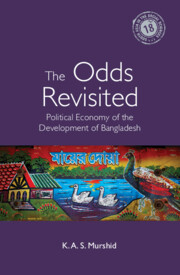Book contents
- Frontmatter
- Dedication
- Contents
- List of Tables and Figures
- Acknowledgements
- List of Abbreviations
- Introduction
- 1 A Bird’s-Eye View of the Bangladesh Economy: 1971–2020
- 2 Initial Conditions: The Odds Revisited
- 3 The Food Security Challenge
- 4 Exploring Transition and Change in the Rice Market
- 5 International Migration
- 6 The Rural Non-farm (RNF) Sector
- 7 Industrialization and the Rise of RMG
- 8 Industrialization: Other Stories
- 9 The Social Sector Puzzle
- 10 Dhaka: Capital Formation—Urbanization, Competition and the Rise of a Business Class
- Conclusion
- Notes
- Glossary
- References
- Index
6 - The Rural Non-farm (RNF) Sector
Published online by Cambridge University Press: 30 June 2022
- Frontmatter
- Dedication
- Contents
- List of Tables and Figures
- Acknowledgements
- List of Abbreviations
- Introduction
- 1 A Bird’s-Eye View of the Bangladesh Economy: 1971–2020
- 2 Initial Conditions: The Odds Revisited
- 3 The Food Security Challenge
- 4 Exploring Transition and Change in the Rice Market
- 5 International Migration
- 6 The Rural Non-farm (RNF) Sector
- 7 Industrialization and the Rise of RMG
- 8 Industrialization: Other Stories
- 9 The Social Sector Puzzle
- 10 Dhaka: Capital Formation—Urbanization, Competition and the Rise of a Business Class
- Conclusion
- Notes
- Glossary
- References
- Index
Summary
Introduction
Traditionally, the RNF sector consisted of an assortment of rural households dependent on a variety of service sector livelihoods comprising artisans, barbers, petty food processors and vendors, craftsmen, milkmen, potters, tinkers, tailors and carpenters. They depended on the custom of the vast farming population whose demands they tried to cater to. However, given low productivity and low rural incomes, the demand for the services of these non-farm groups was low and unstable (mirroring unstable farm incomes), making their livelihoods quite precarious. This was the state of RNF in the 1960s and 1970s, before the advent of the GR.
The more recent development history of East and Southeast Asia and parts of South Asia suggests that rural industry and commerce expand in parallel with agricultural production, as linkages between the two deepen (Ranis and Stewart 1993; Yusuf and Kumar 1996; Bhattacharya 1996). Typically, RNF is viewed as having two distinct components: (a) a high labour productivity segment and (b) a low productivity segment. The former is associated with higher incomes, while the latter operates more as a residual. In the process of rural development, RNF is expected to gradually lose its residual character, giving way to more productive, better-paying activities.
In the context of poverty alleviation, it has been noted that non-farm earnings led to an absolute improvement in incomes of the poor, suggesting that a dynamic RNF sector will have a strong anti-poverty impact (Lanjouw and Lanjouw 1999; Lanjouw 1999; B. Sen 1996; Haggblade and Hazell 1989; Haggblade, Hazell and Brown 1989). In the context of the Indian literature, Lanjouw (2007) and Haggblade, Hazell and Reardon (2010) have argued that the impact is not automatic and in fact appears to be muted with a tendency to bypass the extreme poor. Experience from Bangladesh, however, paints a much more positive picture (Pitt and Khandker 1998; Khandker 2005; Khandker, Khalily and Samad 2016a).
Over a 20-year period (1991–92 to 2010–11), moderate poverty headcount declined from 78 per cent to 27.5 per cent, while extreme poverty declined from 64.8 per cent to 14 per cent.
- Type
- Chapter
- Information
- The Odds RevisitedPolitical Economy of the Development of Bangladesh, pp. 84 - 98Publisher: Cambridge University PressPrint publication year: 2022



